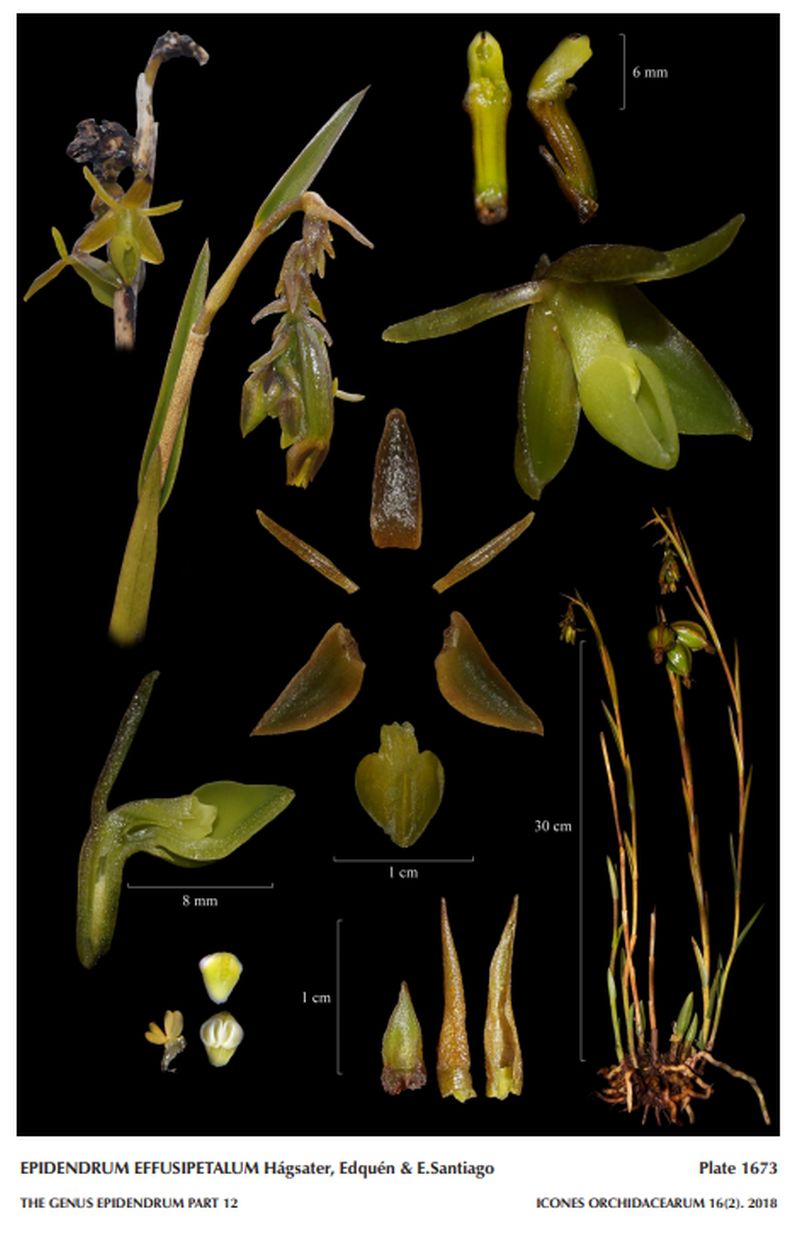

Epidendrum effusipetalum Hágsater, Edquén & E.Santiago 2018 GROUP Frutex SUBGROUP Leptanthum
LCDP Photo /TYPE Photo © by A Diaz and The AMO Herbario Website




Common Name The Wide Spread Sepals Epidendrum
Flower Size 1.2" [3 cm]
Found in Peru along the eastern side of the Andes, on Andean Tepuis, in pajonal at elevations of 2700 to 3900 meters as a medium sized, cold growing terrestrial with cane-like, terete, thin, erect, straight stems carrying 9 to 12, distributed throughout the stem, parallel to the stem, articulate, distichous, coriaceous, green, concolor, slightly concave, base embracing the stem; tubular, rugose, yellowish green foliar sheath; blade , narrowly lanceolate, acuminate, margin entire, spreading leaves that blooms at least in the summer and fall on a terminal, without a spathe, peduncle .28 to .4" [0.7 to 1.0 cm] long, short, terete, thin but not filiform, papilose, provided at the apex with an embracing, narrowly triangular, acuminate, rugose-papillose bract, 1.6 to 2.68" [4.0 to 6.7 cm] long overall, apical and lateral from mature stems, arching-nutant racemose to paniculate with time, producing dense, short, 5-15 per raceme, arranged in a helicoid around the rachis, successively many-flowered inflorescence with shorter than the ovary, widely triangular, acuminate, embracing, dorsally slightly papillose, greenish brown floral bracts and carrying. yellowish green flowers with the sepals dorsally tinged brown, column and lip greenish yellow, concolor; fragrance none.
"Epidendrum effusipetalum belongs to the GROUP Frutex recognized by the caepitose habit, usually simple stems, lanceolate leaves, lacking spathes, nutant racemes, widely cordiform to reniform lip and the SUBGROUP Lepthanthum which is caracterized by the thin stems, scarecely branched when mature, leaves short, linear-lanceolate to lanceolate oblong, nearly parallel to the stem, inflorescence arching-nutant, apical and lateral in mature stems, racemose to paniculate, few-flowered. The new species is recognized by the erect leaves parallel to the stem, few, densely-flowered inflorescence, yellowish green flowers, sepals dorsally tinged brown, outstretched petals, lateral sepals triangular-ovate, obliquely united to the base of the column and ecallose, ovate-cordiform lip. Epidendrum leptanthum is vegetatively very similar, but has a lax-flowered inflorescence, petals partly spreading, lateral sepals ovateoblong, free, and lip bicallose forming a “W”, widely cordiform. Epidendrum podocarpense Hágsater & E.Santiago has fuchsia colored flowers, the ventral surface of tepals and lip pink, petals partly spreading, parallel to the dorsal sepal, lateral sepals free, elliptic, and lip bicallose, widely cordiform. Epidendrum choccei M.A.Tarazona, Hágsater & E.Santiago, has pink colored flowers, column and disc of the lip white, petals partly spreading, acute, sepals free, and lip ecallose, widely ovate, base truncate and apex acuminate. Epidendrum stenophyton Schltr. of the GROUP Elleanthoides SUBGROUP Rhombochilum is vegetatively similar, but the floral bracts are acuminate, proportionately longer than wide, sepals and petals are partly spreading, petals .28" [7 mm] long, linear-lanceolate, acuminate, column ca. .12" [3 mm] long, and lip .1" [2.5 mm] long and rhombic-elliptic." Hagsater etal 2018
Synonyms
References W3 Tropicos, Kew Monocot list , IPNI ;*Icones Orchidacearum 16[2] Plate 1673 Hagsater & Sanchez 2018 drawing/photo fide; Icones Orchidacearum 16[2] Plate 1677 Hagsater & Sanchez 2018 see recognition section; Icones Orchidacearum 16[2] Plate 1696 Hagsater & Jimenez 2018 see recognition section; Icones Orchidacearum 17[1] Plate 1712 Hagsater & Jimenez 2019 see recognition section
----------------------------------------------------------------------------------------------------------